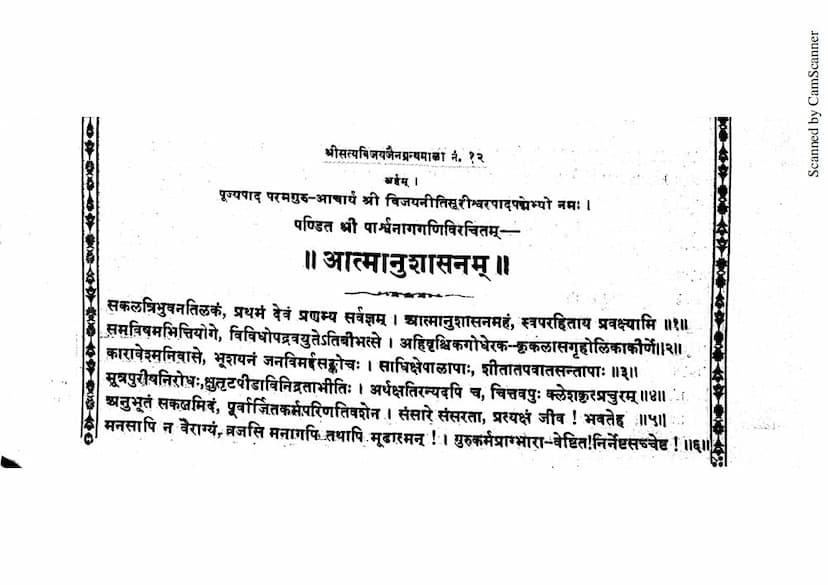Aatmanushasanam
Added to library: September 1, 2025

Summary
Here is a comprehensive summary in English of the Jain text "Aatmanushasanam" by Parshvanaggani, based on the provided pages:
Aatmanushasanam (Self-Discipline) is a profound Jain text authored by the esteemed Muni Parshvanaggani. Published by Satyavijay Jain Granthmala, this work serves as a guide to achieving spiritual liberation by focusing on self-discipline and the understanding of karma. The text is presented as a discourse for the benefit of oneself and others, with a strong emphasis on understanding the nature of suffering and the path to its cessation.
Core Themes and Teachings:
- The Nature of Suffering in Samsara: The text begins by vividly describing the inherent suffering and unpleasantness of existence in the cycle of birth and death (samsara). It details various forms of hardship, including physical ailments, confinement, harsh environments, social humiliation, fear, loss, and mental anguish, attributing these to the consequences of past karma (Page 1-2, verses 2-5).
- Karma as the Determinant of Destiny: A central tenet is that all experiences, whether pleasant or unpleasant, are the direct result of one's own past actions (karma). The text emphasizes that external factors or other people are merely instruments, and individuals are the architects of their own fortunes and misfortunes (Page 2, verses 8-10, 14-16, 18, 24).
- The Impermanence of Worldly Possessions and Relationships: The author repeatedly highlights the transient nature of wealth, youth, relationships, and even life itself. These are described using metaphors for their fleetingness, such as water drops on a lotus leaf, a lamp flame in the wind, and the colors of a sunset (Page 3-4, verses 30-32, 35). Even friends and family can become distant or indifferent in times of adversity, leaving only one's own good and bad karma as true companions (Page 4, verse 37).
- The Futility of Regret and Blame: The text advises against dwelling on past mistakes or blaming others for one's suffering. Since current experiences are the ripening of past karma, it's more productive to accept the consequences and focus on future righteous actions (Page 2, verses 8-10, 14).
- The Importance of Equanimity: The scriptures advocate for maintaining equanimity in both favorable and unfavorable situations. One should not be overly elated by prosperity nor despair in adversity. This balanced approach is presented as the path of the wise and virtuous (Page 2, verse 13).
- The Value of Human Birth: The text stresses that human birth, especially the opportunity to encounter Jain teachings, is incredibly rare and precious. It is a unique chance to perform actions that lead to spiritual advancement. Wasting this opportunity on worldly pursuits or negative actions is depicted as a grave loss (Page 3, verses 27, 39-40).
- Ethical Conduct and Virtues: A significant portion of the text is dedicated to outlining the essential virtues and ethical principles for a spiritual life:
- Non-violence (Ahimsa): Practicing compassion and refraining from harming any living being is paramount (Page 6, verse 59).
- Control over Passions: The text urges the renunciation of anger, pride, greed, deceit, attachment, aversion, envy, cruelty, crookedness, discontent, deception, and ego (Page 4, verse 42).
- Truthfulness and Kindness: Speaking truthfully and avoiding harsh, hurtful words is encouraged (Page 4, verse 41).
- Generosity and Contentment: Cultivating generosity and satisfaction with what one has is vital.
- Sense Control (Jitendriyatva): Mastering the senses is a key aspect of self-discipline (Page 5, verse 51).
- Devotion to Teachers and Scriptures: Reverence for enlightened spiritual guides (gurus) and the sacred teachings (Agamas) of the omniscient ones (Sarvajna) is highly valued (Page 5, verse 51; Page 7, verse 72).
- Repentance and Austerity: Engaging in practices that purify the soul and reduce the weight of karma is essential.
- The Path to Liberation (Moksha): The ultimate goal is liberation from the cycle of samsara. This is achieved through:
- Spiritual Knowledge (Jnana): Understanding the true nature of reality and the soul.
- Righteous Conduct (Achara/Dharma): Living a life aligned with Jain principles, with compassion and non-violence as the essence of dharma (Page 6, verse 61).
- Meditation (Dhyana): Concentrating the mind on spiritual truths, leading to detachment and peace.
- Detachment (Vairagya): Developing disinterest in worldly pleasures and a strong inclination towards liberation (Page 7, verses 72-73, 75).
- The Superiority of Dharma: The text asserts that dharma, particularly the compassionate teachings of the omniscient ones, is the highest pursuit and far more valuable than any worldly achievement like kingdoms, wealth, or even celestial enjoyments (Page 6, verses 62, 64-68). Dharma is the true source of happiness, prosperity, and ultimately, liberation.
Concluding Message:
The book concludes by reiterating that by diligently following the principles of self-discipline as outlined in "Aatmanushasanam," individuals can overcome all suffering and attain ultimate peace and liberation. The text is presented as a guide that, when properly understood and practiced, leads to a life free from sorrow (Page 7, verses 76-77).